BBC Broadcasting House
Public Art Programme 2002 - 2008
Introduction
The Broadcasting House Public Art Programme takes its inspiration from the BBC's role and remit in the 21st century, and, specifically, the unique situation of Broadcasting House as the BBC's international headquarters, the home of Radio and Music and, by 2008, World Service and radio & television News. Global and local networks, broadcasting, communication, speech and sound are the starting points for artists' responses; their proposals encompass public space, light, sound, colour, language, data and information dissemination, video, film and photography, and interactive technologies. Engaging people's creativity is at the core of the programme and artists are working with BBC staff, visitors and local residents, in particular children and young people. There are a number of commissioning strands: Permanent Commissions (exterior and interior), the Temporary Programme (Phase 1 2003-5 and Phase 2 2005-8), Artists-on-Site, and Education/Community Projects. The programme is curated and managed by Modus Operandi Art Consultants.
Permanent Commissions: Exterior
A series of permanent commissions are planned for the new external and internal public spaces; the three principal commissions are outlined below. Each commission is subject to planning permission from the City of Westminster.
World by Mark Pimlott
Mark Pimlott's commission takes the subject of the BBC, the location of its international headquarters and the area between the existing Broadcasting House, the new building and All Souls' Church and transforms it into an artist-designed public space. World will be comparable to a portion of the globe: you will feel as though you are walking on a very special piece of the earth. The surface will be very slightly curved, just perceptible to the eye. It will be lined with markings, like lines of latitude and longitude in gold, silver and white mosaic, meeting at a circular point, a pole, at the north end of the space. Place names from around the world will be engraved into the surface and arranged randomly. Inset into the sphere's surface will be a network of speakers, each broadcasting one of the 43 languages of the World Service and located under the relevant city.
Breathing by Jaume Plensa
Breathing is a subtle, glowing beacon of light; a memorial to news journalists killed in action. Its form, based on the spire of All Souls' Church, is an inverted glass cone with a steel point at its base, and will project like an elegant transparent listening glass out of the roof of the new Egton House. A poem is inscribed into its surface, partially glimpsed from the ground but accessible in its entirety within the building. Its discreet presence alters at night when, for an hour a thin vertical line of transparent white light would project from the sculpture, connecting the building to the night sky. This light line would be programmed and linked to the 6pm and 10pm news output. The work, a metaphor for sound and communication, is a collaboration between Plensa, MJP architects and the engineers Whitby Bird. It will exist in two parts: the major exterior form, and a smaller model inside the public arcade. The work is integral to the architect Sir Richard MacCormac's conception of the new building and is intended to become an iconic landmark for the redevelopment and the London landscape.
Light Work by Martin Richman and Tony Cooper
Artists Martin Richman and Tony Cooper have designed a lighting scheme for All Souls Church, a Grade One listed building which will be 'embraced' by the two prows of the redevelopment, the existing Broadcasting House and the new Egton House. Their scheme will link the neoclassical Church to the 1930's prow of Broadcasting House highlighting in particular the clocks on both buildings - the passage of time - as well as the statuary and carvings. The artists are also consultants on the lighting for the rest of the BBC development.
Permanent Commissions: Interior
A new series of internal public spaces are planned for the redevelopment inviting the BBC's audiences into the building for the very first time. The main space will be an arcade where visitors can access and explore the BBC, from breaking news coverage to the Radio & Television Archive. Art commissions will be a key component within this space and will include an interactive work which runs the length of the arcade. One of the commissions currently under development is:
Close-Up Archive by Ron Haselden
Close-Up is an ever-expanding archive of portraits of BBC staff and visitors, which will begin on site in early 2004, being finally sited by 2007 as an integrated commission. A camera will be sited at the main Broadcasting House entrance and invite visitors/ staff to have their photograph taken. This would then scroll onto a series of colour LED screens; an archive of portraits would build up and be displayed randomly. The archive would eventually find a home in the new building with screens installed in both public and BBC spaces.
Temporary Programme
Art Site is a series of three artists' images by established and emerging artists for the prow of Broadcasting House. Now wrapped and under scaffolding, the 'prow' is an iconic symbol for Broadcasting House, the site where radio broadcasting begun in the 1930s. The artists selected for Art Site have responded laterally to the theme of broadcasting. Fiona Rae's 'Signal', installed from July to November 2003, metaphorically explored the notion of visual sound and exchange.
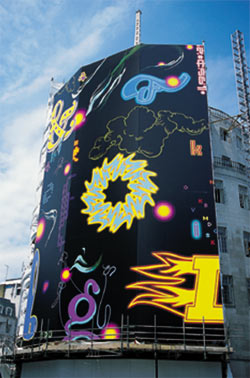
'Signal' by Fiona Rae, courtesy of Timothy Gallery, London
The next image, installed from January to April 2004, is William Furlong's 'Acts of Inscribing' which reveals the hidden sounds of the building and the drama recordings which have taken place inside. The image is a photograph of the Broadcasting House Sound Effects store, accompanied by the sounds of the objects themselves, audible through the wooden hoardings. The programme finishes with Liz Rideal's 'Kerfuffle', installed from May to August 2004, which celebrates the BBC's role as a showbiz producer. Pairs of hands are poised to draw back the red curtains from the newly refurbished building and, within it, the splendid 1930s Radio Theatre.
Artists-on-Site
Under this strand of the Public Art Programme, several artists have recently been invited to respond to the history and activity of Broadcasting House before it closed in 2002/3. Two artists have also been appointed to document the process of transformation. Further artists will be commissioned to mark the closure of Bush House and the transfer of the World Service to the new BH development. The Artists-on-Site series to date has included:
Rachel Whiteread: (sculpture)
Room 101, the inspiration (or one of the inspirations) for Room 101 in George Orwell's novel Nineteen Eighty-four , was demolished in the restructuring of Broadcasting House, and the artist Rachel Whiteread was invited to respond to the room in its last few weeks. Her proposal was to create a cast version of the room. The resultant sculpture is being shown in the Cast Courts at the V&A until the end of June 2004.
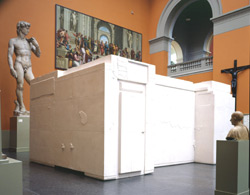
Untitled (Room 101) by Rachel Whiteread, 2003, installed in the Cast Courts of the V&A Museum, courtesy Gagosian Gallery
John Riddy: Architectural Documentation (photographs)
John Riddy has been appointed to document the architectural transformation of Broadcasting House throughout its redevelopment from 2002 to 2008. Riddy began working in June 2002 photographing the interiors of Broadcasting House and Egton House before they closed. He has begun to build up an extensive archive of images of interior spaces including the old Radio 1 studios in Egton House which have now been demolished and the Council Chamber, Drama Studio and Radio Theatre in Broadcasting House which are undergoing refurbishment. His black and white photographs will become part of the BBC's Art Collection and other possible outputs include a book, postcard series and an exhibition. His photographs of Room 101, taken after Rachel Whiteread had cast the space, are on show in the gallery above the Cast Courts in the V & A until 31 December 2003.
Nick Danziger: BBC People Documentation: Radio with Pictures (photographs)
Nick Danziger has began to document and record BBC staff, in their current working environments, who will eventually be based on the Broadcasting House site. Danziger will document the working processes and current broadcasting Ãîlife' of these departments and have the opportunity to record behind the scenes on programmes such as Radio 1's DJ sessions, the Today Programme, Panorama and Outlook. He will also follow the World Service staff in Bush House recording the many different nationalities and the 43 language services based there.
The team involved in the redevelopment, including BBC staff, architects, contractors, consultants to artists will also be documented. Images will range from everyday activity on the building site to remarkable one-off events such as the installation of Rachel Whiteread's cast of Room 101.
William Furlong: (audio work)
The Sound Effects Store in Broadcasting House was the source for William Furlong's audiowork. Furlong's work is a collage of these different sound effects collected from a variety of objects, a choreographed work of different tones and durations. Usually the objects act as props within radio drama; here Furlong allows them a life of their own. The work is a prelude to his proposal for a permanent audiowork.
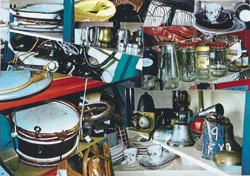
Photomontage by William Furlong of the Broadcasting House Sound Effects Store, 2003.
© 2003 William Furlong
Brian Catling: (video)
Brian Catling's video features a blind man's investigation of objects from the Sound Effects Store selected for their sound potential in radio drama. The video opens with images of the Broadcasting House drama studio and the sounds of someone walking in the studio's gravel pit. Each object examined by the man generates a shard of a story and time period through touch using different expressions and forms of language. A block of wood mounted with dials and buttons becomes the console for a space ship, a suitcase the actor in a drama of love and loss.
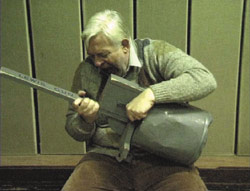
Still from Brian Catling video 'Presence', shot in the old Drama Studio in Broadcasting House, inspired by objects selected from the former Sound Effects Store
© Brian Catling, 2002
Tom Gidley: (film)
Tom Gidley's film explores the empty corridors, offices and stairwells of Broadcasting House. Broadcasting House itself is the film's subject matter as a repository of events and narratives related to the production of sound broadcasting and the juxtaposition of rooms and objects found there. Listening to radio broadcasts can transport us to other places, removing us from our surroundings. The artist suggests this disjuncture visually by creating a nocturnal and other-worldly atmosphere against a background of silence. The journey leads to an empty room and open window through which sound of the outside world seeps in. This is Room 101, the inspiration for Orwell's torture chamber in 1984.
Catherine Yass: (film)
Flight, a film by artist Catherine Yass, shot by a camera attached to a model helicopter, swooping over the roofs of Broadcasting House, has already become an important archival record of a view and buildings now lost. The film was shot in just one take, which lasted a couple of minutes, with the helicopter following a circular looping path over the roof of the Broadcasting House Extension and onto Langham Street around the cooling tower and aerials, the main point of transmission for the BBC's radio output from this location. It gives us a bird's-eye-view among the rooftops, following the path of the radio waves, capturing a collage of different architectural forms and objects. This disembodied, vertiginous experience re-imagines the city and the BBC's central location as a moving aerial landscape. Flight was shown as part of the artist's Turner Prize entry in 2002.
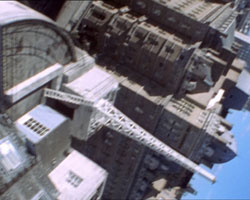
Still from Catherine Yass video ' Flight' shot over the roofscapes of Broadcasting House, its extension, Egton House, and Langham Street, with Hovercam.
© 2002 Catherine Yass
Education and Community Programme
Involving young people is a key objective of the Broadcasting House Public Art Programme; links have been made with local schools and colleges. Under a pilot education project, artists Richard Wentworth and Ruth Maclennan used some of the objects from the Sound Effects Store as the starting point for making films with 15 nine year olds from Gateway School, Westminster, exploring found sounds, movement and people in the vicinity.
A project with the BBC's 21CC and All Souls' Primary School is due to begin in early 2004, with pupils at the school following the redevelopment process through until 2008. They will work on specific projects with artists/ architects/ composers/ writers exploring issues and themes highlighted by the redevelopment and the Public Art Programme.
A joint initiative between the BBC's 21CC, Modus Operandi and Creative Partnerships has recently been established, and a pilot project linking the schools Quintin Kynaston in Westminster and Stoke Newington school in Hackney will start from 2004.
Residencies by artists, poets, choreographers, architects and composers will also beorganised in local schools, and there are ideas for linking these to international partner schools through the World Service's networks.
The BBC Broadcasting House Public Art Programme is led by Modus Operandi Art Consultants. Further information from: Vivien Lovell at [email protected]
© Modus Operandi, November 2003
Further information on the Public Art Programme is at www.bbc.co.uk/pressoffice
